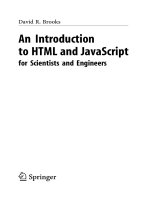ssl and remote access vpns an introduction to designing and configuring ssl virtual private networks
Bạn đang xem bản rút gọn của tài liệu. Xem và tải ngay bản đầy đủ của tài liệu tại đây (12.4 MB, 369 trang )
Cisco Press
800 East 96th Street
Indianapolis, IN 46240 USA
Cisco Press
SSL Remote Access VPNs
Jazib Frahim, CCIE No. 5459
Qiang Huang, CCIE No. 4937
ii
SSL Remote Access VPNs
Jazib Frahim, Qiang Huang
Copyright© 2008 Cisco Systems, Inc.
Published by:
Cisco Press
800 East 96th Street
Indianapolis, IN 46240 USA
All rights reserved. No part of this book may be reproduced or transmitted in any form or by any means, electronic
or mechanical, including photocopying, recording, or by any information storage and retrieval system, without writ-
ten permission from the publisher, except for the inclusion of brief quotations in a review.
Printed in the United States of America
First Printing June 2008
Library of Congress Catalog Card Number: 2005923483
ISBN-13: 978-1-58705-242-2
ISBN-10: 1-58705-242-3
Warning and Disclaimer
This book is designed to provide information about the Secure Socket Layer (SSL) Virtual Private Network (VPN)
technology on Cisco products. Every effort has been made to make this book as complete and as accurate as possi-
ble, but no warranty or fitness is implied.
The information is provided on an “as is” basis. The authors, Cisco Press, and Cisco Systems, Inc. shall have neither
liability nor responsibility to any person or entity with respect to any loss or damages arising from the information
contained in this book or from the use of the discs or programs that may accompany it.
The opinions expressed in this book belong to the author and are not necessarily those of Cisco Systems, Inc.
Trademark Acknowledgments
All terms mentioned in this book that are known to be trademarks or service marks have been appropriately capital-
ized. Cisco Press or Cisco Systems, Inc., cannot attest to the accuracy of this information. Use of a term in this book
should not be regarded as affecting the validity of any trademark or service mark.
Corporate and Government Sales
The publisher offers excellent discounts on this book when ordered in quantity for bulk purchases or special sales,
which may include electronic versions and/or custom covers and content particular to your business, training goals,
marketing focus, and branding interests. For more information, please contact: U.S. Corporate and Government
Sales 1-800-382-3419
For sales outside the United States, please contact: International Sales
iii
Feedback Information
At Cisco Press, our goal is to create in-depth technical books of the highest quality and value. Each book is crafted
with care and precision, undergoing rigorous development that involves the unique expertise of members from the
professional technical community.
Readers’ feedback is a natural continuation of this process. If you have any comments regarding how we could
improve the quality of this book, or otherwise alter it to better suit your needs, you can contact us through e-mail at
Please make sure to include the book title and ISBN in your message.
We greatly appreciate your assistance.
Publisher Paul Boger
Associate Publisher Dave Dusthimer
Cisco Press Program Manager Jeff Brady
Executive Editor Brett Bartow
Managing Editor Patrick Kanouse
Development Editor Betsey Henkels
Senior Project Editor Tonya Simpson
Copy Editor Written Elegance, Inc.
Technical Editors Pete Davis, Dave Garneau
Editorial Assistant Vanessa Evans
Book Designer Louisa Adair
Composition Mark Shirar
Indexer Heather McNeil
Proofreader Sheri Cain
iv
About the Authors
Jazib Frahim, CCIE No. 5459, has been with Cisco for more than nine years. Having a bachelor’s
degree in computer engineering from Illinois Institute of Technology, he started out as a TAC engineer
in the LAN Switching team. He then moved to the TAC Security team, where he acted as a technical
leader for the security products. He led a team of 20 engineers in resolving complicated security and
VPN technologies. He is currently working as a technical leader in the Worldwide Security Services
Practice of Advanced Services for Network Security. He is responsible for guiding customers in the
design and implementation of their networks with a focus on network security. He holds two CCIEs,
one in routing and switching and the other in security. He has written numerous Cisco online technical
documents and has been an active member on the Cisco online forum NetPro. He has presented at Net-
workers on multiple occasions and has taught many on-site and online courses to Cisco customers, part-
ners, and employees.
He has recently received his master of business administration (MBA) degree from North Carolina State
University. He is also an author of the following Cisco Press books: Cisco Network Admission Control,
Volume II: NAC Deployment and Troubleshooting, and Cisco ASA: All-in-One Firewall, IPS, and VPN
Adaptive Security Appliance.
Qiang Huang, CCIE No. 4937, is a product manager in the Cisco Systems Campus Switch System
Technology Group, focusing on driving the security and intelligent services roadmap for Cisco market-
leading modular Ethernet switching platforms. He has been with Cisco for almost ten years. During his
time at Cisco, Qiang played an important role in a number of technology groups including the follow-
ing: technical lead in the Cisco TAC security and VPN team, where he was responsible for troubleshoot-
ing complicated customer deployments in security and VPN solutions; a security consulting engineer in
the Cisco Advanced Service Group, providing security posture assessment and consulting services to
customers; a technical marketing engineer focusing on competitive analysis and market intelligence in
network security with specialization in the emerging SSL VPN technology. Qiang has extensive knowl-
edge of security and VPN technologies and experience in real-life customer deployments. Qiang holds
CCIE certifications in routing and switching, security, and ISP dial. He is also one of the contributing
authors of Internetworking Technologies Handbook, Fourth Edition. Qiang received a master’s degree in
electrical engineering from Colorado State University.
v
About the Technical Reviewers
Pete Davis has been working with computers and networks since he was able to walk. By age 15, he
was one of the youngest professional network engineers and one of the first employees at an Internet
service provider. Pete implemented and maintained the systems and networks behind New England’s
largest consumer Internet service provider, TIAC (The Internet Access Company). In 1997, Pete joined
Shiva Corporation as a product specialist. Since 1998, Pete has been with Altiga Networks, a VPN con-
centrator manufacturer in Franklin, Massachusetts, that was acquired by Cisco on March 29, 2000. As
product line manager, Pete is responsible for driving new VPN-related products and features.
Dave Garneau is principal consultant and senior technical instructor at The Radix Group, Ltd., a con-
sulting and training company based in Henderson, Nevada, and focusing on network security. As a con-
sultant, he specializes in Cisco network security (including IronPort, now part of Cisco) and VPN
technologies (both IPsec and SSL VPN). As an instructor, he has trained more than 2500 people in eight
countries to earn certifications throughout the Cisco and IronPort certification programs. He has written
lab guides used worldwide by authorized Cisco Learning Partners, as well as publishing papers related
to network security. Dave holds the following certifications: CCSP, CCNP, CCDP, CCSI, CCNA,
CCDA, ICSP, ICSI, and CNE.
vi
Dedications
Jazib Frahim:
I would like to dedicate this book to my lovely wife, Sadaf, who has patiently put up with me during the
writing process.
I would also like to dedicate this book to my parents, Frahim and Perveen, who support and encourage
me in all my endeavors.
Finally, I would like to thank my siblings, including my brother Shazib and sisters Erum and Sana,
sister-in-law Asiya, my cute nephew Shayan, and my adorable nieces Shiza and Alisha. Thank you for
your patience and understanding during the development of this book.
Qiang Huang:
I would like to dedicate this book to my parents, who always taught me to make better use of my free
time, and to my wife for her patience and support of this project.
vii
Acknowledgments
We would like to thank the technical editors, Pete Davis and David Garneau, for their time and technical
expertise. They verified our work and provided recommendations on how to improve the quality of this
manuscript. We would also like to thank Vincent Shan, Andy Qin, James Fu, and Awair Waheed from
the Cisco Security Technical Group for their help and guidance. We also recognize Saddat Malik for
providing content source for several figures in Chapter 2. Special thanks go to Scott Enicke and Aun
Raza for reviewing this book prior to final editing.
We would like to thank the Cisco Press team, especially Brett Bartow and Betsey Henkels, for their
patience, guidance, and consideration. Their efforts are greatly appreciated.
Many thanks to our managers, Ken Cavanagh, Raj Gulani, and Hasan Siraj, for their continuous support
throughout this project.
Finally, we would like to acknowledge the Cisco TAC. Some of the best and brightest minds in the net-
working industry work there, supporting our Cisco customers often under very stressful conditions and
working miracles daily. They are truly unsung heroes, and we are all honored to have had the privilege
of working side by side with them in the trenches of the TAC.
viii
ix
Contents at a Glance
Introduction xviii
Chapter 1 Introduction to Remote Access VPN Technologies 3
Chapter 2 SSL VPN Technology 17
Chapter 3 SSL VPN Design Considerations 63
Chapter 4 Cisco SSL VPN Family of Products 85
Chapter 5 SSL VPNs on Cisco ASA 93
Chapter 6 SSL VPNs on Cisco IOS Routers 223
Chapter 7 Management of SSL VPNs 313
Index 332
x
Contents
Introduction xviii
Chapter 1 Introduction to Remote Access VPN Technologies 3
Remote Access Technologies 5
IPsec 5
Software-Based VPN Clients 7
Hardware-Based VPN Clients 7
SSL VPN 7
L2TP 9
L2TP over IPsec 11
PPTP 13
Summary 14
Chapter 2 SSL VPN Technology 17
Cryptographic Building Blocks of SSL VPNs 17
Hashing and Message Integrity Authentication 17
Hashing 18
Message Authentication Code 18
Encryption 20
RC4 21
DES and 3DES 22
AES 22
Diffie-Hellman 23
RSA and DSA 24
Digital Signatures and Digital Certification 24
Digital Signatures 24
Public Key Infrastructure, Digital Certificates, and Certification 25
SSL and TLS 30
SSL and TLS History 30
SSL Protocols Overview 31
OSI Layer Placement and TCP/IP Protocol Support 31
SSL Record Protocol and Handshake Protocols 33
SSL Connection Setup 34
Application Data 42
Case Study: SSL Connection Setup 43
DTLS 48
xi
SSL VPN 49
Reverse Proxy Technology 50
URL Mangling 52
Content Rewriting 53
Port-Forwarding Technology 55
Terminal Services 58
SSL VPN Tunnel Client 58
Summary 59
References 60
Chapter 3 SSL VPN Design Considerations 63
Not All Resource Access Methods Are Equal 63
User Authentication and Access Privilege Management 65
User Authentication 66
Choice of Authentication Servers 66
AAA Server Scalability and High Availability 67
AAA Server Scalability 67
AAA Server High Availability and Resiliency 68
Resource Access Privilege Management 68
Security Considerations 70
Security Threats 71
Lack of Security on Unmanaged Computers 71
Data Theft 71
Man-in-the-Middle Attacks 72
Web Application Attack 73
Spread of Viruses, Worms, and Trojans from Remote Computers to the Internal
Network 73
Split Tunneling 73
Password Attacks 74
Security Risk Mitigation 74
Strong User Authentication and Password Policy 75
Choose Strong Cryptographic Algorithms 75
Session Timeout and Persistent Sessions 75
Endpoint Security Posture Assessment and Validation 75
VPN Session Data Protection 76
Techniques to Prevent Data Theft 76
Web Application Firewalls, Intrusion Prevention Systems, and Antivirus and
Network Admission Control Technologies 77
Device Placement 78
Platform Options 79
xii
Virtualization 79
High Availability 80
Performance and Scalability 81
Summary 82
References 82
Chapter 4 Cisco SSL VPN Family of Products 85
Overview of Cisco SSL VPN Product Portfolio 85
Cisco ASA 5500 Series 87
SSL VPN History on Cisco ASA 87
SSL VPN Specifications on Cisco ASA 88
SSL VPN Licenses on Cisco ASA 89
Cisco IOS Routers 90
SSL VPN History on Cisco IOS Routers 90
SSL VPN Licenses on Cisco IOS Routers 90
Summary 91
Chapter 5 SSL VPNs on Cisco ASA 93
SSL VPN Design Considerations 93
SSL VPN Prerequisites 95
SSL VPN Licenses 95
Client Operating System and Browser and Software Requirements 96
Infrastructure Requirements 97
Pre-SSL VPN Configuration Guide 97
Enrolling Digital Certificates (Recommended) 98
Step 1: Configuring a Trustpoint 98
Step 2: Obtaining a CA Certificate 99
Step 3: Obtaining an Identity Certificate 100
Setting Up ASDM 101
Uploading ASDM 102
Setting Up the Appliance 103
Accessing ASDM 104
Setting Up Tunnel and Group Policies 106
Configuring Group-Policies 107
Configuring a Tunnel Group 110
Setting Up User Authentication 110
Clientless SSL VPN Configuration Guide 114
Enabling Clientless SSL VPN on an Interface 116
xiii
Configuring SSL VPN Portal Customization 117
Logon Page 118
Portal Page 123
Logout Page 125
Portal Customization and User Group 126
Full Customization 129
Configuring Bookmarks 134
Configuring Websites 135
Configuring File Servers 137
Applying a Bookmark List to a Group Policy 139
Single Sign-On 140
Configuring Web-Type ACLs 141
Configuring Application Access 144
Configuring Port Forwarding 144
Configuring Smart Tunnels 147
Configuring Client-Server Plug-Ins 150
AnyConnect VPN Client Configuration Guide 152
Loading the SVC Package 154
Defining AnyConnect VPN Client Attributes 155
Enabling AnyConnect VPN Client Functionality 155
Defining a Pool of Addresses 156
Configuring Traffic Filters 159
Configuring a Tunnel Group 159
Advanced Full Tunnel Features 159
Split Tunneling 159
DNS and WINS Assignment 161
Keeping the SSL VPN Client Installed 162
Configuring DTLS 163
Cisco Secure Desktop 164
CSD Components 165
Secure Desktop Manager 165
Secure Desktop 165
Cache Cleaner 166
CSD Requirements 166
Supported Operating Systems 166
User Privileges 167
Supported Internet Browsers 167
Internet Browser Settings 167
CSD Architecture 168
Configuring CSD 169
Loading the CSD Package 169
Defining Prelogin Sequences 170
xiv
Host Scan 182
Host Scan Modules 183
Basic Host Scan 183
Endpoint Assessment 183
Advanced Endpoint Assessment 184
Configuring Host Scan 184
Setting Up Basic Host Scan 184
Enabling Endpoint Host Scan 186
Setting Up an Advanced Endpoint Host Scan 187
Dynamic Access Policies 189
DAP Architecture 190
DAP Records 191
DAP Selection Rules 191
DAP Configuration File 191
DAP Sequence of Events 191
Configuring DAP 192
Selecting a AAA Attribute 193
Selecting Endpoint Attributes 195
Defining Access Policies 197
Deployment Scenarios 205
AnyConnect Client with CSD and External Authentication 206
Step 1: Set Up CSD 207
Step 2: Set Up RADIUS for Authentication 207
Step 3: Configure AnyConnect SSL VPN 208
Clientless Connections with DAP 209
Step 1: Define Clientless Connections 210
Step 2: Configuring DAP 211
Monitoring and Troubleshooting SSL VPN 212
Monitoring SSL VPN 212
Troubleshooting SSL VPN 215
Troubleshooting SSL Negotiations 215
Troubleshooting AnyConnect Client Issues 215
Troubleshooting Clientless Issues 217
Troubleshooting CSD 219
Troubleshooting DAP 219
Summary 220
Chapter 6 SSL VPNs on Cisco IOS Routers 223
SSL VPN Design Considerations 223
IOS SSL VPN Prerequisites 225
xv
IOS SSL VPN Configuration Guide 226
Configuring Pre-SSL VPN Setup 226
Setting Up User Authentication 226
Enrolling Digital Certificates (Recommended) 229
Loading SDM (Recommended) 232
Initial SSL VPN Configuration 235
Step 1: Setting Up an SSL VPN Gateway 237
Step 2: Setting Up an SSL VPN Context 239
Step 3: Configuring SSL VPN Look and Feel 241
Step 4: Configuring SSL VPN Group Policies 245
Advanced SSL VPN Features 247
Configuring Clientless SSL VPNs 247
Windows File Sharing 253
Configuring Application ACL 257
Thin Client SSL VPNs 259
Step 1: Defining Port-Forwarding Lists 261
Step 2: Mapping Port-Forwarding Lists to a Group Policy 262
AnyConnect SSL VPN Client 264
Step 1: Loading the AnyConnect Package 264
Step 2: Defining AnyConnect VPN Client Attributes 266
Cisco Secure Desktop 276
CSD Components 277
Secure Desktop Manager 277
Secure Desktop 277
Cache Cleaner 278
CSD Requirements 278
Supported Operating Systems 278
User Privileges 279
Supported Internet Browsers 279
Internet Browser Settings 279
CSD Architecture 280
Configuring CSD 281
Step 1: Loading the CSD Package 282
Step 2: Launching the CSD Package 283
Step 3: Defining Policies for Windows-Based Clients 283
Defining Policies for Windows CE 298
Defining Policies for the Mac and Linux Cache Cleaner 298
Deployment Scenarios 301
Clientless Connections with CSD 301
Step 1: User Authentication and DNS 302
Step 2: Set Up CSD 303
Step 3: Define Clientless Connections 303
xvi
AnyConnect Client and External Authentication 304
Step 1: Set Up RADIUS for Authentication 305
Step 2: Install the AnyConnect SSL VPN 306
Step 3: Configure AnyConnect SSL VPN Properties 306
Monitoring an SSL VPN in Cisco IOS 307
Summary 311
Chapter 7 Management of SSL VPNs 313
Multidevice Policy Provisioning 314
Device View and Policy View 314
Device View 314
Policy View 318
Use of Common Objects for Multidevice Management 320
Workflow Control and Role-Based Access Control 322
Workflow Control 323
Workflow Mode 324
Role-Based Administration 326
Native Mode 326
Cisco Secure ACS Integration Mode 327
Summary 331
References 331
Index 332
xvii
Icons Used in This Book
Command Syntax Conventions
The conventions used to present command syntax in this book are the same conventions used in the IOS
Command Reference. The Command Reference describes these conventions as follows:
• Boldface indicates commands and keywords that are entered literally as shown. In actual con-
figuration examples and output (not general command syntax), boldface indicates commands
that are manually input by the user (such as a show command).
• Italics indicate arguments for which you supply actual values.
• Vertical bars (|) separate alternative, mutually exclusive elements.
• Square brackets [ ] indicate optional elements.
• Braces { } indicate a required choice.
• Braces within brackets [{ }] indicate a required choice within an optional element.
Router
Hub
Gateway
Workgroup
Switch
ISDN Switch
Multilayer
Switch
Bridge
Laptop
Printer
Modem
Firewall
File Server
IP Phone
Network Cloud
Workstation
Mainframe
Integrated
Router
Handheld
Route/Switch
Processor
Wireless
Access Point
Wireless
Bridge
Wireless
Media
WAN Media
LAN Media
xviii
Introduction
This book provides a complete guide to the SSL VPN technology and discusses its implementation on
Cisco SSL VPN–capable devices. Design guidance is provided to assist you in implementing SSL VPNs
in an existing network infrastructure. This includes examining existing hardware and software to deter-
mine whether they are SSL VPN capable, providing design recommendations, and guiding you on set-
ting up the Cisco SSL VPN devices.
Toward the end of Chapters 5 and 6, common deployment scenarios are covered to assist you in deploy-
ing an SSL VPN in your network.
Who Should Read This Book?
This book serves as a guide for network professionals who want to implement the Cisco SSL VPN
remote access solution in their network to allow users to access the corporate resources easily and
safely. The book systematically walks you through the product or solution architecture, installation,
configuration, deployment, monitoring, and troubleshooting the SSL VPN solution. Any network pro-
fessional should be able to use this book as a guide to successfully deploy SSL VPN remote access solu-
tions in their network. Requirements include a basic knowledge of TCP/IP and networking, familiarity
with Cisco routers/firewalls and their command-line interface (CLI), and a general understanding of the
overall SSL VPN solution.
How This Book Is Organized
Part I of this book includes Chapters 1 and 2, which provide an overview of the remote access VPN
technologies and introduce the SSL VPN technology. The remainder of the book is divided into two
parts.
Part II encompasses Chapters 3 and 4 and introduces the Cisco SSL VPN product lines, with guidance
on different design considerations.
Part III encompasses Chapters 5 through 7 and covers the installation, configuration, deployment, and
troubleshooting of the individual components that make up the SSL VPN solution.
• Part I, “Introduction and Technology Overview,” includes the following chapters:
Chapter 1, “Introduction to Remote Access VPN Technologies”: This chapter covers the
remote access Virtual Private Network (VPN) technologies in detail. Protocols, such as the
Point-to-Point Tunneling Protocol (PPTP), Internet Protocol Security (IPsec), Layer 2 For-
warding (L2F), Layer 2 Tunneling Protocol (L2TP) over IPsec, and SSL VPN, are discussed to
provide readers with an overview of the available remote access VPN technologies.
Chapter 2, “SSL VPN Technology”: This chapter provides a technology overview of the build-
ing blocks of SSL VPNs, including cryptographic algorithms, SSL and Transport Layer Secu-
rity (TLS), and common SSL VPN technologies.
xix
• Part II, “SSL VPN Design Considerations and Cisco Solution Overview,” includes the follow-
ing chapters:
Chapter 3, “SSL VPN Design Considerations”: This chapter discusses the common design best
practices for planning and designing an SSL VPN solution.
Chapter 4, “Cisco SSL VPN Family of Products”: This chapter discusses the SSL VPN func-
tionality on Cisco Adaptive Security Appliance (ASA) and Cisco IOS routers and provides
product specifications that are focused on SSL VPNs.
• Part III, “Deploying Cisco SSL VPN Solutions,” includes the following chapters:
Chapter 5, “SSL VPNs on Cisco ASA”: This chapter provides details about the SSL VPN func-
tionality in Cisco ASA. This chapter discusses clientless and full tunnel SSL VPN client imple-
mentations and focuses on Cisco Secure Desktop (CSD). This chapter also discusses the Host
Scan feature that is used to collect posture information about end workstations. The dynamic
access policy (DAP) feature, its usage, and detailed configuration examples are also provided.
To reinforce learning, many different deployment scenarios are presented along with their con-
figurations.
Chapter 6, “SSL VPNs on Cisco IOS Routers”: This chapter provides details about the SSL
VPN functionality in Cisco IOS routers. It begins by offering design guidance and then dis-
cusses the configuration of SSL VPNs in greater detail. The configurations of clientless, thin
client, and AnyConnect Client modes are discussed. The second half of the chapter focuses on
Cisco Secure Desktop (CSD) and offers guidance in setting up CSD features. To reinforce
learning, two different deployment scenarios are presented along with their configurations.
Toward the end of this chapter, SSL VPN monitoring through SDM is also discussed.
Chapter 7, “Management of SSL VPNs”: This chapter discusses the central management of
SSL VPN devices using Cisco Security Manager.
This chapter covers the following topics:
• IPsec
•
SSL VPN
•
L2TP
• L2TP over IPsec
•
PPTP
C
HAPTER
1
Introduction to Remote
Access VPN Technologies
Since the advent of the Internet, network administrators have looked for ways to leverage
this low-cost, widespread medium to transport data while protecting data integrity and
confidentiality. They looked for ways to protect the information within the data packets
while providing transparency to the end user. This spawned the concept of Virtual Private
Networks (VPN). Subsequently, the Internet Engineering Task Force (IETF) was engaged
to craft standard protocols and procedures to be used by all vendors of VPNs for data
protection and confidentiality.
The IETF defined a number of VPN protocols, including Point-to-Point Tunneling Protocol
(PPTP), Layer 2 Forwarding (L2F) Protocol, Layer 2 Tunneling Protocol (L2TP), Generic
Routing Encapsulation (GRE) Protocol, Multiprotocol Label Switching (MPLS) VPN,
Internet Protocol Security (IPsec), and Secure Socket Layer VPN (SSL VPN).
VPN protocols can be categorized into two distinct groups:
•
Site-to-site protocols
• Remote access protocols
Site-to-site protocols allow an organization to establish secure connections between two or
more offices so that it can send traffic back and forth using a shared medium such as the
Internet. These connections can also be used to connect the private or semiprivate networks
of an organization with the private or semiprivate networks of a different organization over
the shared medium. This eliminates the need for dedicated leased lines to connect the
remote offices to the organization’s network. IPsec, GRE, and MPLS VPN are commonly
used site-to-site VPN protocols.
Figure 1-1 shows a simple IPsec VPN topology that SecureMe (a fictitious company) is
planning to deploy. SecureMe wants to ensure that the two locations (Chicago and London)
can communicate over the Internet without risking the integrity of their data. In this
network diagram, host A resides on the private network of the Chicago router and sends a
packet to host B that exists on the private network of the London router. When the Chicago
router receives the clear-text packet, it encrypts the datagram based on the negotiated
security policies and then forwards the encrypted datagram to the other end of the VPN
tunnel. The London router receives and decrypts the datagram and eventually forwards it to
the destination host B. Without access to the negotiated security policies (or keys) required
4 Chapter 1: Introduction to Remote Access VPN Technologies
to decrypt the packet, the information enclosed within the packet remains secure while the
packet traverses the public Internet.
Figure 1-1 IPsec Site-to-Site VPN Tunnel
The remote access protocols benefit an organization by allowing mobile users to work from
remote locations such as home, hotels, airport internet kiosks and Internet cafes as if they
were directly connected to their organization’s network. Organizations do not need to
maintain a huge pool of modems and access servers to accommodate remote users.
Additionally, they save money by not having to pay for the toll-free numbers and long-
distance phone charges. Some commonly used remote access VPN protocols are SSL VPN,
IPsec, L2TP, L2TP over IPsec, and PPTP.
Figure 1-2 shows a deployment model in which different types of remote users are using
the remote access VPN technologies. The figure illustrates a mobile user, a home-office
user, and a number of small branch office users accessing corporate resources using the
remote access protocols.
Figure 1-2 Remote Access Deployment
Chicago London
Host A Host B
Message Message
Message Message
Users Behind
Branch Office
Internet
Home-Office User
Corporate
Network
Mobile
User
Remote Access Tunnel
Remote Access Tunnel
Remote Access Tunnel
IPsec 5
Many enterprises prefer to use IPsec because it can be used as either a site-to-site or remote
access protocol. Additionally, IPsec is an obvious choice for a number of vendors because
of its robust feature set and security characteristics, including data integrity and packet and
data encryption. However, other VPN methods are commonly used as well, depending on
the requirements and infrastructure of an organization. SSL VPN is becoming a preferred
choice for many organizations because of its benefits. In many cases, it allows remote
access VPN users to access corporate resources without needing to install additional
software on the shared workstations.
Remote Access Technologies
Organizations are constantly under pressure to reduce costs by leveraging newer
technology in their existing network infrastructure. With the growth of the Internet and
greater focus on globalization, organizations are required to provide their employees with
24/7 access to organizational resources. The increasing number of mobile workers and
telecommuters is a major factor in the exponential growth of remote access technologies.
These users require the traditional LAN-based applications, such as data, voice, and video,
to work seamlessly, thereby giving users the illusion of being directly connected to the
corporate LAN. This chapter discusses a number of remote access technologies, including
the following:
•
IPsec
• SSL VPN
• L2TP
•
L2TP over IPsec
•
PPTP
The sections that follow discuss all these technologies.
IPsec
IPsec is the most widely used VPN technology. Because it provides protection at the IP
level (Layer 3), it can be deployed to secure communication between a pair of gateways, a
pair of host computers, or even between a gateway and a host computer. It offers the
security features that are required in the enterprise and service provider infrastructures.
IPsec was designed to provide data integrity to ensure that packets have not been modified
during transmission, packet authentication to make sure that packets are coming from a
valid source, and data encryption to assure confidentiality of the content.
6 Chapter 1: Introduction to Remote Access VPN Technologies
NOTE A number of RFCs provide the framework for IPsec. They include RFC 2401–2412, 2104,
1829, and 1851.
Internet Key Exchange (IKE) uses the framework provided by the Internet Security
Association and Key Management Protocol (ISAKMP) and parts of two other key
management protocols, namely Oakley and Secure Key Exchange Mechanism (SKEME).
The purpose of IKE, as defined in RFC 2409, “The Internet Key Exchange,” is to negotiate
different security associations (SA) by using the available key management protocols.
ISAKMP negotiates using two phases. In Phase 1, ISAKMP creates a secure and authentic
communication channel between the peers. By using this bidirectional channel, the VPN
peers can agree on how the further negotiation should be handled by sending protected
messages to one another. Phase 2 negotiations then create two unidirectional channels that
are used to secure and authenticate the actual data packets.
The Cisco IPsec remote access solution introduces two additional sets of negotiations to
successfully negotiate an IPsec tunnel. These negotiations, also referred to as Phase 1.5,
include extended authentication (X-AUTH) and mode configuration (mode config) to
provide additional security enhancements. Figure 1-3 illustrates these different phases.
During X-AUTH, the VPN client is prompted to provide user credentials for authentication.
After successful authentication, the IPsec gateway pushes a number of configuration
parameters and security policies to the end-user connection in mode config.
Figure 1-3 IPsec Phases in Cisco Devices
The Cisco IPsec remote access solution comes in two different flavors:
•
Software-based VPN clients
• Hardware-based VPN clients
VPN Client
Initiator
IPsec
Gateway
Responder
IPsec (Phase 2)
Phase 1.5 (XAUTH, Mode-config)
Data
IKE (Phase 1)









